Research on Drainage Rights Allocation Based on Game Combination Weight-Improved Matter-Element Extension Model
Abstract
1. Introduction
2. Literature Review
- (1)
- Improves the index system affecting the allocation of drainage rights. The DPSIR model is used to further improve the factors affecting the initial allocation of drainage rights, and this paper emphasizes the process of influencing the allocation of drainage rights compared with previous studies, presenting a “driving force-pressure-state-influence-response” logical relationship;
- (2)
- Provides a reasonable determination of drainage rights index weights. In this paper, we use subjective and objective methods to determine the weights of the indicators affecting the allocation of drainage rights, which makes the indicator weighting results more reasonable;
- (3)
- Extends the application of an improved matter-element extension model in the field of drainage rights. This paper takes a different approach from other scholars to evaluate the allocation of drainage rights and further expands the research results of the evaluation method of drainage rights allocation.
3. Materials and Methods
3.1. Study Area
3.2. Methods
3.2.1. Principles of Drainage Rights Distribution
3.2.2. Indicator System Construction
3.2.3. Model Construction
Game Combination Weights Determination
- (1)
- Hierarchical analysis to determine the subjective weights
- (2)
- Entropy weighting method to determine objective weights
- (3)
- Game theory to determine the portfolio weights
Improved Matter-Element Extension Evaluation Model
- (1)
- Determine the classical domain
- (2)
- Determine the object element
- (3)
- Closeness calculation
- (4)
- Allocation weight of drainage rights
3.2.4. Data Sources
3.2.5. Model Application
4. Results
4.1. Indicator Weights
4.2. Determining the Classical Domain and Object Elements
4.3. Closeness Results
4.4. Results of Drainage Rights Allocation
5. Discussion
5.1. System Evaluation
5.1.1. Driving Force System
5.1.2. Pressure System
5.1.3. State System
5.1.4. Impact System
5.1.5. Response System
5.2. Comprehensive Evaluation
5.2.1. Wuxi and Suzhou
5.2.2. Changzhou
5.2.3. Zhenjiang
6. Conclusions
- (1)
- Drainage rights allocation is affected by various aspects, such as social, economic, and ecological. It is a complex decision problem. The DPSIR model was used to construct a system of indicators affecting the allocation of drainage rights, and 20 indicators were finally selected, taking into account the availability and accuracy of the data. The most influential indicators are ecological and economic: water surface rate, maximum seven-day rainfall return period, and GDP per capita. Therefore, the coordination of ecology and economy should be fully considered in the process of social development, taking into account both ecological and economic development.
- (2)
- The method of comprehensive subjective and objective assignment is adopted in the determination of weights, which makes up for the arbitrariness of subjective assignments and the dependence of objective assignments on the data, and the experts were repeatedly consulted in the process of weight determination, making the assignment results more reasonable.
- (3)
- The final determination of the size of the drainage rights allocation of the four cities in the south Jiangsu canal region from 2017 to 2021 was according to the game combination weight-improved matter-element extension model. The 2017–2021 drainage rights quota size order the cities as Wuxi, Suzhou, Changzhou, and Zhenjiang. Ddeveloped areas have priority over the less developed areas, where Suzhou and Wuxi drainage rights fall. The quotas are similar, and the difference between the quotas of Suzhou and Wuxi and Zhenjiang is large. The determination of the size of drainage rights allocation in the south Jiangsu canal region provides a reference value for drainage rights trading in the south Jiangsu region.
- (4)
- The drainage rights allocation method of the game combination weight-improved matter-element extension model provides a new research idea for the drainage rights allocation of the basin, and the results of the case analysis provide a direction and reference for improving the flood control and drainage system. A reasonable and efficient allocation of drainage rights can reduce flood losses for the region and lay the foundation for drainage rights trading.
Author Contributions
Funding
Data Availability Statement
Conflicts of Interest
References
- Wentz, F.J.; Ricciardulli, L.; Hilburn, K.; Mears, C. How much more rain will global warming bring? Science 2007, 317, 233–235. [Google Scholar] [CrossRef]
- Li, S.; Goldberg, M.D.; Sjoberg, W.; Zhou, L.; Nandi, S.; Chowdhury, N.; Straka, W.; Yang, T.; Sun, D. Assessment of the Catastrophic Asia Floods and Potentially Affected Population in Summer 2020 Using VIIRS Flood Products. Remote Sens. 2020, 12, 3176. [Google Scholar] [CrossRef]
- Li, Z.; Li, Q.; Bai, C.; Che, T.; Liu, M. Design and application of intelligent water integrated management and control platform system in Zhusi River Basin. China Water Supply Drain. 2023, 39, 118–126. [Google Scholar]
- Cui, Y.; Luo, Q.; Liu, L. Flood prediction algorithm based on improved nonlinear autoregressive network. J. Shenyang Univ. Technol. 2023, 45, 84–89. [Google Scholar]
- Wu, X.; Zhao, X.; Ding, Q.; Xu, Z.; Qiu, C. Flood evolution prediction method based on data-driven CNN. J. Hydropower 2021, 40, 79–86. [Google Scholar]
- Chen, H.; Zhao, Y.; Liang, Z. Technology and practice of joint dispatching in the lower reaches of Jinsha River and Three Gorges Cascade reservoirs. People’s Chang. River 2022, 53, 203–210. [Google Scholar]
- Yu, F.; Wang, Y.; Yuan, X.; Jiang, S. The concept of drainage rights and its basic characteristics. J. Irrig. Drain. 2014, 33, 134–137. [Google Scholar]
- Zhang, J.; Zhang, C.; Liu, L.; Shen, J.; Zhang, D.; Sun, F. The necessity and feasibility of allocation and transaction of drainage rights in Jiangsu Province. Water Resour. Conserv. 2019, 35, 25–28+130. [Google Scholar]
- Lai, X.; Sun, F.; Shen, J.; Gao, X.; Zhang, D. Influencing factors of regional drainage rights allocation based on WSR. Water Conserv. Econ. 2020, 38, 74–80+4. [Google Scholar]
- Shen, J.; Li, L.; Zhang, K.; Sun, F.; Zhang, D. Initial allocation of drainage weight based on chaotic Optimization-projection pursuit. Resour. Ind. 2019, 21, 39–47. [Google Scholar]
- Shen, J.; Zhao, M.; Wang, C.; Zhang, D.; Zhan, Q.; Sun, F. Research on the allocation of drainage rights based on the game-theoretic combined empowerment-TOPSIS model. Water Conserv. Econ. 2021, 39, 42–49+96. [Google Scholar]
- Shen, J.; Yang, J.; Wang, L.; Sun, F. Research on initial allocation of drainage rights based on Gini Coefficient optimization entropy weight-TOPSIS method. Water Conserv. Econ. 2022, 40, 46–50+6+89. [Google Scholar]
- Wu, F.; Cao, Q.; Zhang, D.; Sun, F.; Shen, J. Allocation of drainage rights in Southern Jiangsu Canal based on environmental Gini coefficient. J. Hohai Univ. (Nat. Sci. Ed.) 2020, 48, 314–319. [Google Scholar]
- Zhang, D.D.; Shen, J.Q.; Sun, F.H.; Liu, B.; Wang, Z.Y.; Zhang, K.Z.; Li, L. Research on the Allocation of Flood Drainage Rights of the Sunan Canal Based on a Bi-level Multi-Objective Programming Model. Water 2019, 11, 1769. [Google Scholar] [CrossRef]
- Sun, F.H.; Lai, X.P.; Shen, J.Q.; Nie, L.B.; Gao, X. Initial allocation of flood drainage rights based on a PSR model and entropy-based matter-element theory in the Sunan Canal, China. PLoS ONE 2020, 15, e0233570. [Google Scholar] [CrossRef]
- Zhang, X.Y.; Shen, J.Q.; Sun, F.H.; Wang, S.; Zhang, S.X.; Chen, J. Allocation of Flood Drainage Rights in Watershed Using a Hybrid FBWM-Grey-TOPSIS Method: A Case Study of the Jiangsu Section of the Sunan Canal, China. Int. J. Env. Res. Public Health 2022, 19, 8180. [Google Scholar] [CrossRef]
- Shen, J.Q.; Zhu, T.T.; Sun, F.H. A Study on the Mechanism and Pricing of Drainage Rights Trading Based on the Bilateral Call Auction Model and Wealth Utility Function. Water 2022, 14, 2269. [Google Scholar] [CrossRef]
- Zhang, L.; Shi, Y.; Liu, H.; Li, F. Research on initial water rights allocation of reservoir based on matter-element extension theory. China Popul. Resour. Environ. 2019, 29, 110–117. [Google Scholar]
- Zhu, Y.; He, H.; Zhang, W.; Du, S. Water resource vulnerability assessment in Changchun based on DPSIR-TOPSIS model. Bull. Soil Water Conserv. 2022, 42, 174–180. [Google Scholar]
- Li, J.; Zeng, X.; Cao, Q.; Ji, Y. Safety assessment and trend prediction of karst mountain tourism ecosystem: A case study of Guizhou International mountain tourism destinations. Ecol. Econ. 2022, 38, 145–151. [Google Scholar]
- Ma, X.; Shao, L.; Zhang, D.; Li, F.; Huang, L.; Chen, J. DPSIR based coordination evaluation and analysis model for HSR and rail transit transfer systems. J. Railw. Sci. Eng. 2023, 20, 1232–1241. [Google Scholar]
- Sun, C.; Gao, J.; Xu, J. Research on the improvement of regional public cultural service level based on DPSIR framework: A case study of 11 provinces and cities in the Yangtze River Economic Belt. Libr. Theory Pract. 2022, 258, 53–60+7. [Google Scholar]
- Cai, W. Extension theory and its applications. Chin. Sci. Bull. 1999, 44, 1538–1548. [Google Scholar] [CrossRef]
- Hasekiogullari, G.D.; Ercanoglu, M. A new approach to use AHP in landslide susceptibility mapping: A case study at Yenice (Karabuk, NW Turkey). Nat. Hazards 2012, 63, 1157–1179. [Google Scholar] [CrossRef]
- Zhang, K.; Shen, J.; Guo, L.; Boyer, E.W.; Mello, C.R.; Lan, P.; Liu, H.; Gao, J.; Fan, B. Flood drainage rights in watersheds based on the harmonious allocation method. J. Hydrol. 2021, 601, 126627. [Google Scholar] [CrossRef]


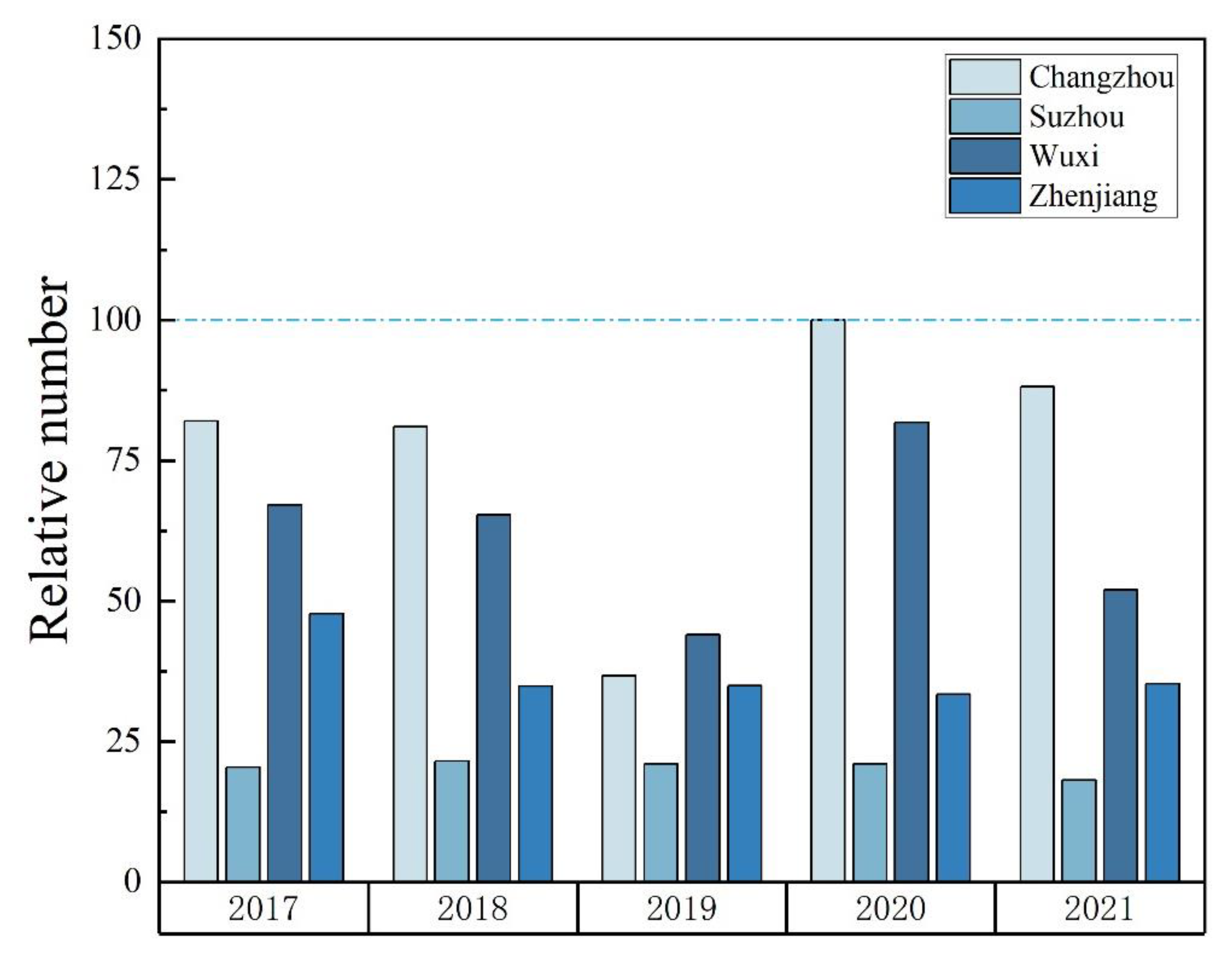
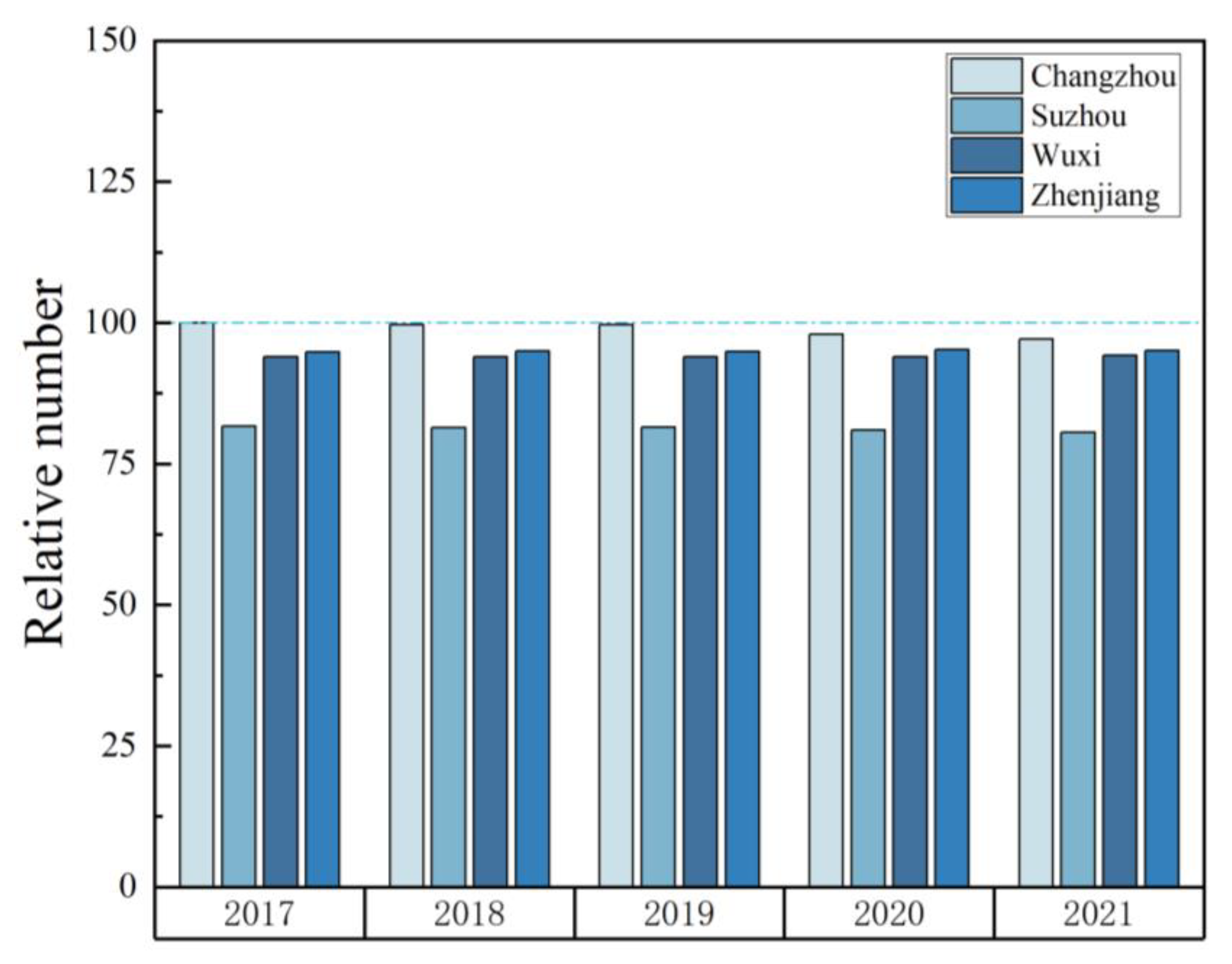
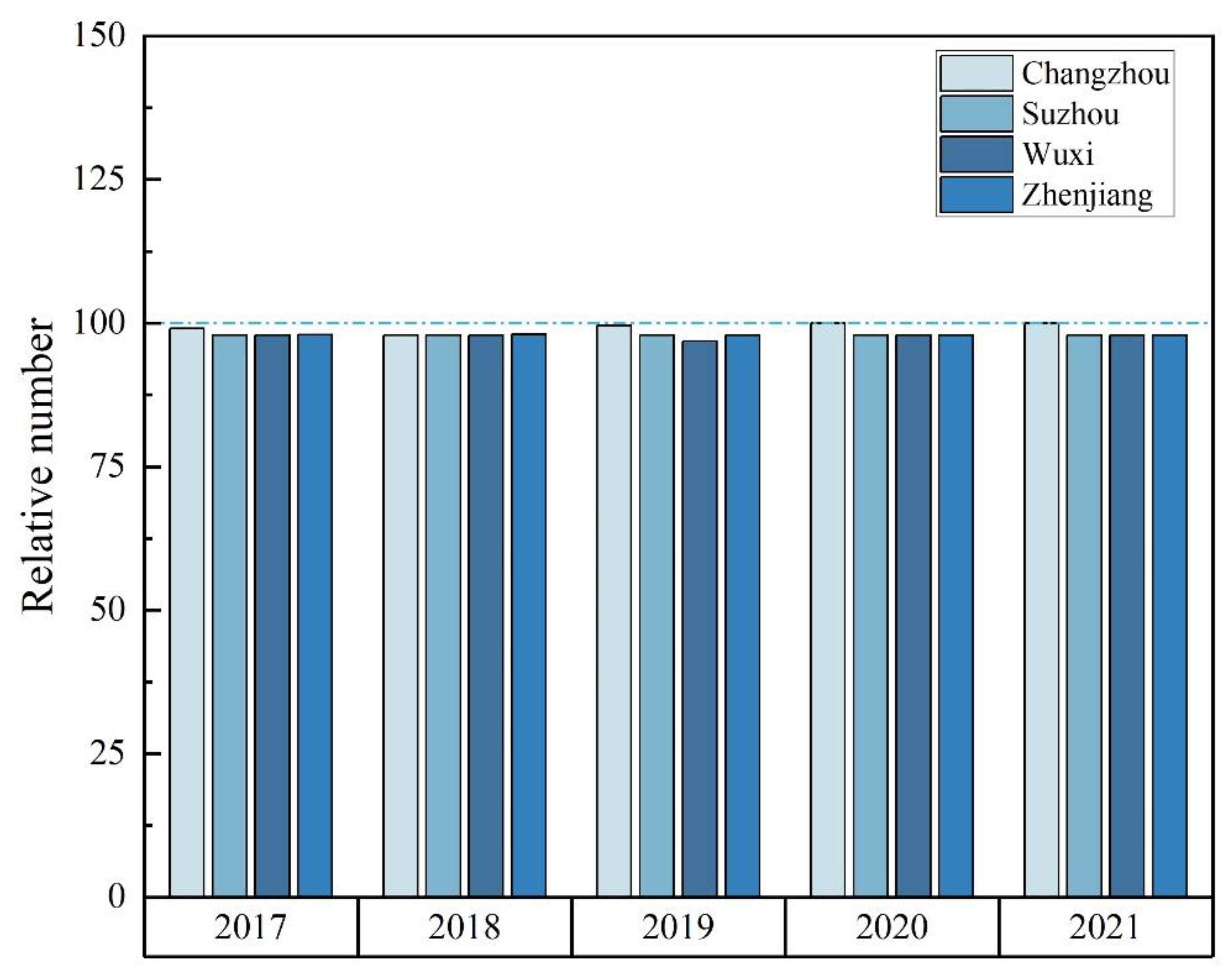
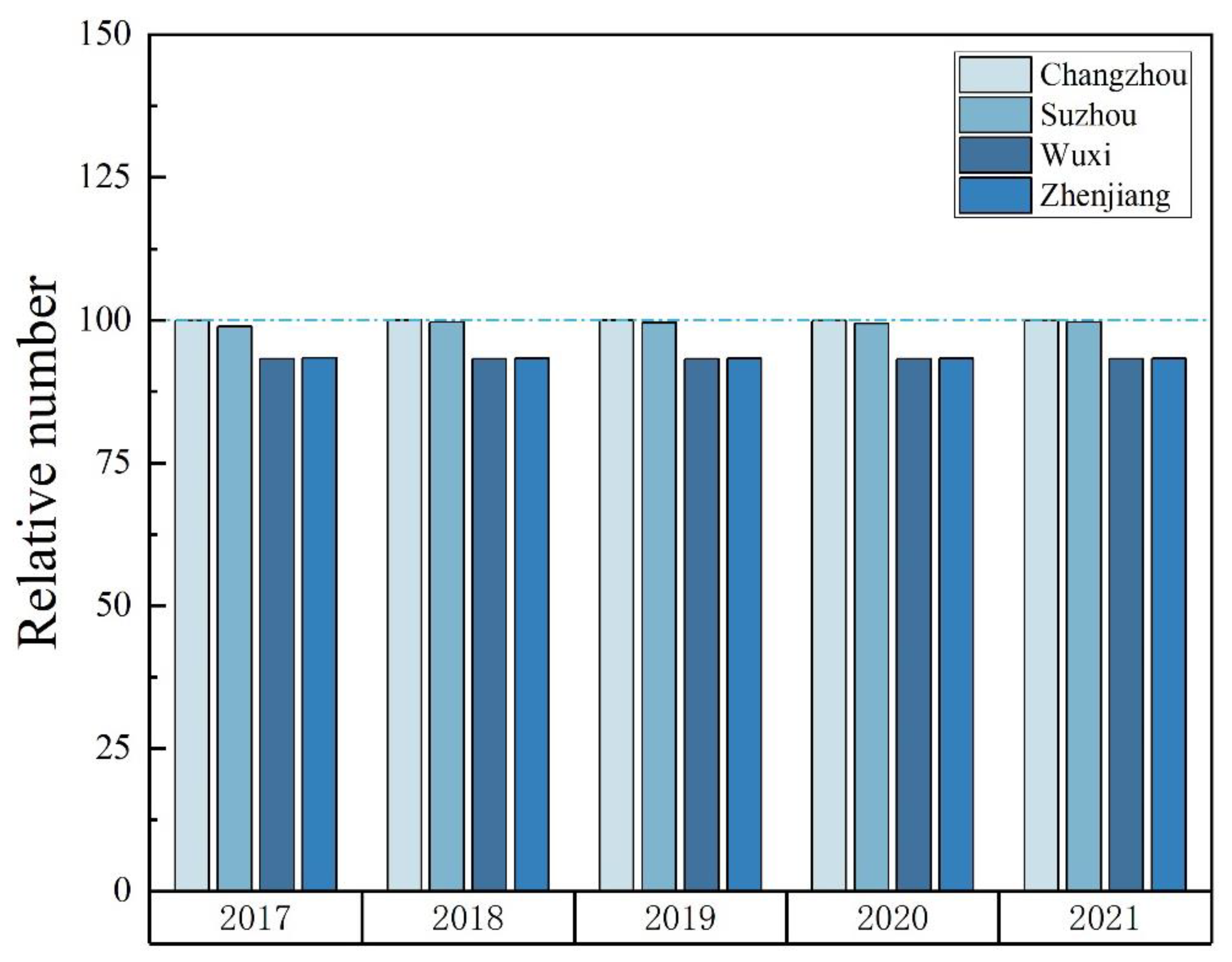
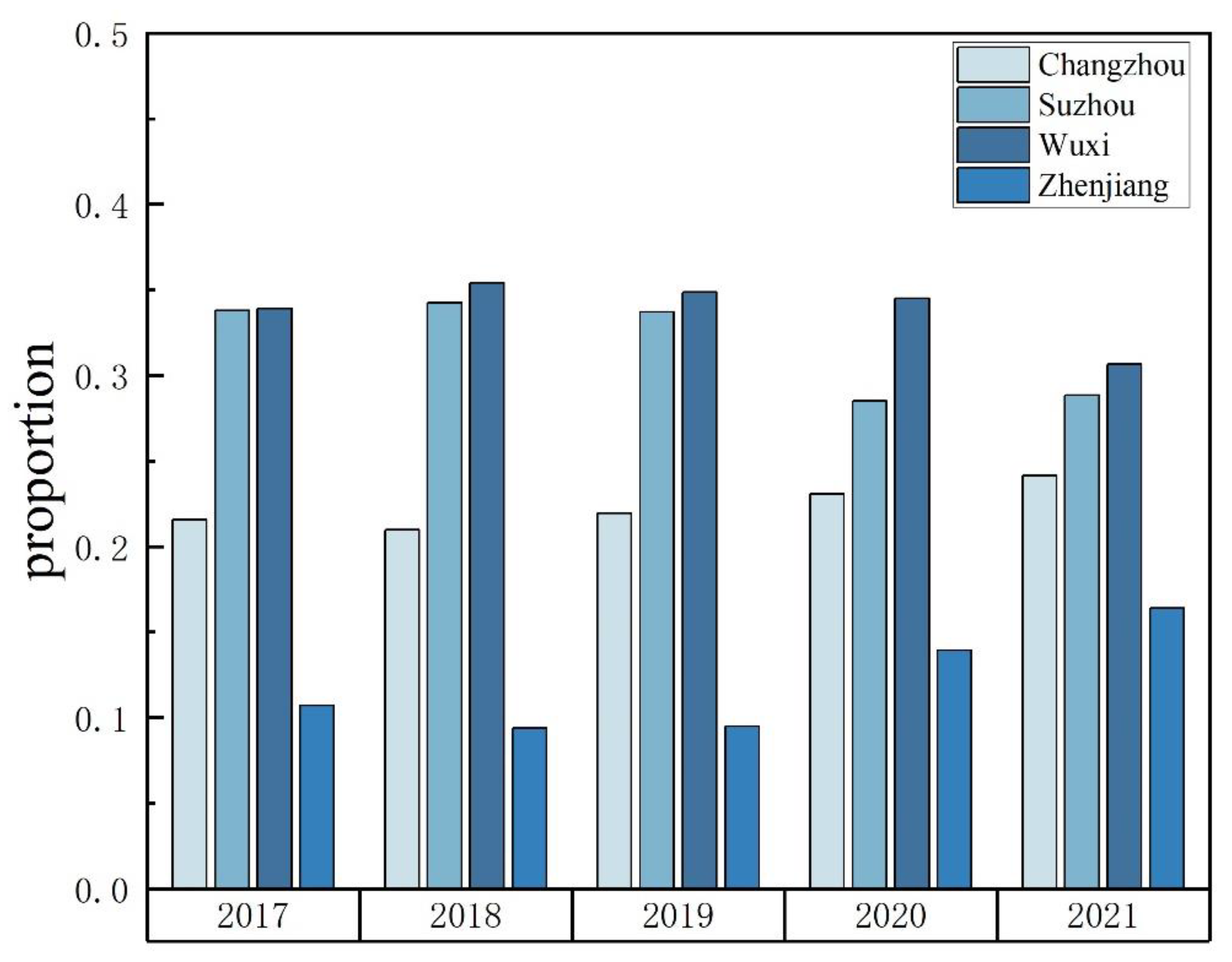
| Target Layer | Guideline Layer | Indicator Layer | Symbols | Nature of Indicator | References |
|---|---|---|---|---|---|
| Initial allocation of drainage rights | Driving force | Green Coverage | D1 | Negative | [8,10] |
| Water surface rate | D2 | Negative | [8,10] | ||
| GDP per capita | D3 | Positive | [13,14,15] | ||
| Disposable income per capita | D4 | Positive | [13,14,15] | ||
| Employment rate | D5 | Positive | [13,14,15] | ||
| Urbanization rate | D6 | Positive | [13,14,15] | ||
| Pressure | Annual precipitation | P1 | Positive | [8,9,10] | |
| Maximum seven-day rainstorm recurrence period | P2 | Positive | [8,9,10] | ||
| Water level | P3 | Positive | [8,9,10] | ||
| State | Total length of embankment | S1 | Negative | [8,9] | |
| Drainage pipe density | S2 | Negative | [8,9] | ||
| Number of hydrological stations | S3 | Negative | [8,9] | ||
| Impact | Affected Population | I1 | Positive | [10] | |
| Crop damage area | I2 | Positive | [10] | ||
| Direct economic loss | I3 | Positive | [10] | ||
| Response | Sewage treatment rate | R1 | Negative | [9,11] | |
| Construction of drainage facilities | R2 | Negative | [9,11] | ||
| Number of people with bachelor’s degree or above | R3 | Negative | [23] | ||
| Disaster command and control capabilities | R4 | Negative | [14] | ||
| Disaster Emergency Management Capability | R5 | Negative | [14] |
| Target Layer | Guideline Layer | Weights | Indicator Layer | AHP | Entropy Power | Gaming Portfolio Weights | Sort by |
|---|---|---|---|---|---|---|---|
| Initial allocation of drainage rights | Driving force | 46.02% | Green Coverage | 0.09 | 0.04 | 0.08 | 5 |
| Water surface rate | 0.13 | 0.06 | 0.12 | 3 | |||
| GDP per capita | 0.15 | 0.05 | 0.12 | 2 | |||
| Disposable income per capita | 0.12 | 0.04 | 0.10 | 4 | |||
| Employment rate | 0.05 | 0.02 | 0.04 | 9 | |||
| Urbanization rate | 0.02 | 0.05 | 0.03 | 12 | |||
| Pressure | 17.72% | Annual precipitation | 0.03 | 0.02 | 0.03 | 15 | |
| Maximum seven-day rainstorm recurrence period | 0.13 | 0.08 | 0.12 | 1 | |||
| Water level | 0.03 | 0.05 | 0.04 | 10 | |||
| State | 11.86% | Total length of embankment | 0.01 | 0.07 | 0.03 | 13 | |
| Drainage pipe density | 0.05 | 0.08 | 0.07 | 7 | |||
| Number of hydrological stations | 0.01 | 0.06 | 0.03 | 14 | |||
| Impact | 11.94% | Affected Population | 0.08 | 0.04 | 0.08 | 6 | |
| Crop damage area | 0.02 | 0.04 | 0.03 | 16 | |||
| Direct economic loss | 0.02 | 0.03 | 0.02 | 17 | |||
| Response | 12.47% | Sewage treatment rate | 0.00 | 0.05 | 0.02 | 18 | |
| Construction of drainage facilities | 0.01 | 0.02 | 0.01 | 20 | |||
| Number of people with bachelor’s degree or above | 0.00 | 0.04 | 0.02 | 19 | |||
| Disaster command and control capabilities | 0.01 | 0.08 | 0.03 | 11 | |||
| Disaster Emergency Management Capability | 0.03 | 0.08 | 0.05 | 8 |
| Year | Region | ||||||
|---|---|---|---|---|---|---|---|
| 2017 | Changzhou | 0.43 | 0.71 | 0.99 | 0.95 | 0.35 | 1.53 |
| Suzhou | 1.29 | 1.16 | 0.86 | 0.57 | 0.00 | 2.40 | |
| Wuxi | 1.25 | 1.20 | 0.90 | 0.60 | 0.00 | 2.41 | |
| Zhenjiang | 0.01 | 0.28 | 0.56 | 1.13 | 0.77 | 0.76 | |
| 2018 | Changzhou | 0.69 | 0.97 | 1.00 | 0.69 | 0.10 | 1.84 |
| Suzhou | 1.96 | 1.16 | 0.86 | 0.57 | 0.00 | 3.01 | |
| Wuxi | 2.03 | 1.20 | 0.90 | 0.60 | 0.00 | 3.11 | |
| Zhenjiang | 0.03 | 0.32 | 0.60 | 1.17 | 0.75 | 0.82 | |
| 2019 | Changzhou | 0.95 | 1.18 | 0.89 | 0.59 | 0.00 | 2.13 |
| Suzhou | 2.26 | 1.16 | 0.86 | 0.57 | 0.00 | 3.27 | |
| Wuxi | 2.34 | 1.19 | 0.90 | 0.60 | 0.00 | 3.39 | |
| Zhenjiang | 0.06 | 0.36 | 0.66 | 1.25 | 0.72 | 0.92 | |
| 2020 | Changzhou | 0.65 | 0.92 | 1.02 | 0.72 | 0.12 | 1.81 |
| Suzhou | 1.10 | 1.16 | 0.86 | 0.57 | 0.00 | 2.23 | |
| Wuxi | 1.56 | 1.20 | 0.90 | 0.59 | 0.00 | 2.70 | |
| Zhenjiang | 0.16 | 0.45 | 0.73 | 1.21 | 0.62 | 1.09 | |
| 2021 | Changzhou | 1.54 | 1.20 | 0.90 | 0.59 | 0.00 | 2.68 |
| Suzhou | 2.17 | 1.16 | 0.86 | 0.57 | 0.00 | 3.20 | |
| Wuxi | 2.34 | 1.20 | 0.90 | 0.60 | 0.00 | 3.40 | |
| Zhenjiang | 0.64 | 0.94 | 1.03 | 0.74 | 0.14 | 1.82 |
| Year | Region | Allocation Ratio |
|---|---|---|
| 2017 | Changzhou | 21.58% |
| Suzhou | 33.79% | |
| Wuxi | 33.90% | |
| Zhenjiang | 10.72% | |
| 2018 | Changzhou | 20.98% |
| Suzhou | 34.24% | |
| Wuxi | 35.41% | |
| Zhenjiang | 9.37% | |
| 2019 | Changzhou | 21.93% |
| Suzhou | 33.70% | |
| Wuxi | 34.87% | |
| Zhenjiang | 9.49% | |
| 2020 | Changzhou | 23.08% |
| Suzhou | 28.49% | |
| Wuxi | 34.49% | |
| Zhenjiang | 13.95% | |
| 2021 | Changzhou | 24.14% |
| Suzhou | 28.83% | |
| Wuxi | 30.64% | |
| Zhenjiang | 16.39% |
Disclaimer/Publisher’s Note: The statements, opinions and data contained in all publications are solely those of the individual author(s) and contributor(s) and not of MDPI and/or the editor(s). MDPI and/or the editor(s) disclaim responsibility for any injury to people or property resulting from any ideas, methods, instructions or products referred to in the content. |
© 2023 by the authors. Licensee MDPI, Basel, Switzerland. This article is an open access article distributed under the terms and conditions of the Creative Commons Attribution (CC BY) license (https://creativecommons.org/licenses/by/4.0/).
Share and Cite
Sun, F.; Luo, Y.; Shen, J. Research on Drainage Rights Allocation Based on Game Combination Weight-Improved Matter-Element Extension Model. Water 2023, 15, 2044. https://doi.org/10.3390/w15112044
Sun F, Luo Y, Shen J. Research on Drainage Rights Allocation Based on Game Combination Weight-Improved Matter-Element Extension Model. Water. 2023; 15(11):2044. https://doi.org/10.3390/w15112044
Chicago/Turabian StyleSun, Fuhua, Yuyu Luo, and Juqin Shen. 2023. "Research on Drainage Rights Allocation Based on Game Combination Weight-Improved Matter-Element Extension Model" Water 15, no. 11: 2044. https://doi.org/10.3390/w15112044
APA StyleSun, F., Luo, Y., & Shen, J. (2023). Research on Drainage Rights Allocation Based on Game Combination Weight-Improved Matter-Element Extension Model. Water, 15(11), 2044. https://doi.org/10.3390/w15112044





